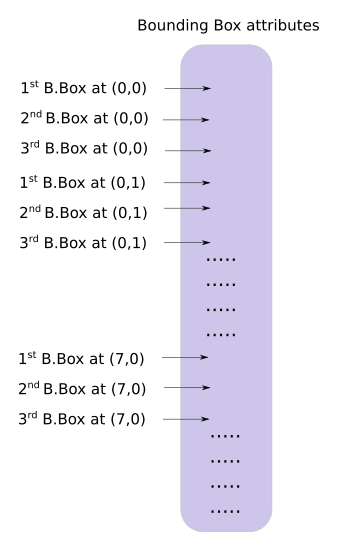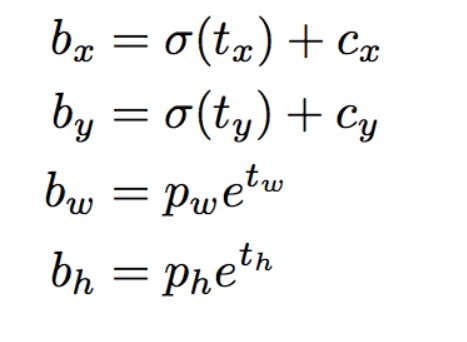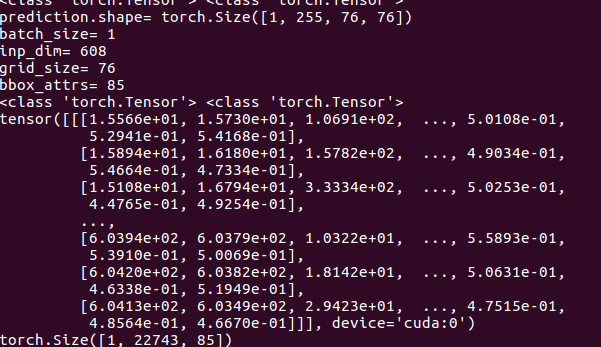pytorch實現yolov3(3) 實現forward
之前的文章裡https://www.cnblogs.com/sdu20112013/p/11099244.html實現了網路的各個layer.
本篇來實現網路的forward的過程.
定義網路
class Darknet(nn.Module):
def __init__(self, cfgfile):
super(Darknet, self).__init__()
self.blocks = parse_cfg(cfgfile)
self.net_info, self.module_list = create_modules(self.blocks)實現網路的forward過程
forward函式繼承自nn.Module
Convolutional and Upsample Layers
if module_type == "convolutional" or module_type == "upsample":
x = self.module_list[i](x)Route Layer / Shortcut Layer
在上一篇裡講過了,route layer的輸出是之前某一層或某兩層在depth方向的連線.即
output[current_layer] = output[previous_layer] 或者 map1 = outputs[i + layers[0]] map2 = outputs[i + layers[1]] output[current layer]=torch.cat((map1, map2), 1)
所以route layer程式碼如下:
elif module_type == "route": layers = module["layers"] layers = [int(a) for a in layers] if (layers[0]) > 0: layers[0] = layers[0] - i if len(layers) == 1: x = outputs[i + (layers[0])] else: if (layers[1]) > 0: layers[1] = layers[1] - i map1 = outputs[i + layers[0]] map2 = outputs[i + layers[1]] x = torch.cat((map1, map2), 1)
shortcut layer的輸出為前一層及前xx層(配置檔案中配置)的輸出之和
elif module_type == "shortcut":
from_ = int(module["from"])
x = outputs[i-1] + outputs[i+from_]YOLO layer
yolo層的輸出是一個n*n*depth的feature map矩陣.假設你想訪問第(5,6)個cell的第2個boundingbox的話你需要map[5,6,(5+C):2*(5+C)]這樣訪問,這種形式操作起來有點麻煩,所以我們引入一個predict_transform函式來改變一下輸出的形式.
簡而言之我們希望把一個batch_size*grid_size*grid_size*(B*(5+C))的4-D矩陣轉換為batch_size*(grid_size*grid_size*B)*(5+C)的矩陣.
2-D矩陣的每一行的排列如下:

batch_size = prediction.size(0)
stride = inp_dim // prediction.size(2)
grid_size = inp_dim // stride
bbox_attrs = 5 + num_classes
num_anchors = len(anchors)
prediction = prediction.view(batch_size, bbox_attrs*num_anchors, grid_size*grid_size)
prediction = prediction.transpose(1,2).contiguous()
prediction = prediction.view(batch_size, grid_size*grid_size*num_anchors, bbox_attrs)
上述程式碼涉及到pytorch中view的用法,和numpy中resize類似.contiguous一般與transpose,permute,view搭配使用,維度變換後tensor在記憶體中不再是連續儲存的,而view操作要求連續儲存,所以需要contiguous.最終我們得到一個batch_size*(grid_size*grid_size*num_anchors)*bbox_attrs的矩陣.
接下來要對預測boundingbox的座標.


注意此時prediction[:,:,0],prediction[:,:,1],prediction[:,:,2],prediction[:,:,3]prediction[:,:,4]即相應的tx,ty,tw,th,obj score.
接下來是預測相對當前cell左上角的offset
#sigmoid轉換為0-1範圍內
#Sigmoid the centre_X, centre_Y. and object confidencce
prediction[:,:,0] = torch.sigmoid(prediction[:,:,0])
prediction[:,:,1] = torch.sigmoid(prediction[:,:,1])
prediction[:,:,4] = torch.sigmoid(prediction[:,:,4])
#Add the center offsets
grid = np.arange(grid_size)
a,b = np.meshgrid(grid, grid)
x_offset = torch.FloatTensor(a).view(-1,1)
y_offset = torch.FloatTensor(b).view(-1,1)
if CUDA:
x_offset = x_offset.cuda()
y_offset = y_offset.cuda()
x_y_offset = torch.cat((x_offset, y_offset), 1).repeat(1,num_anchors).view(-1,2).unsqueeze(0)
#prediction[:,:,:0],prediction[:,:,:1]修改為相對於當前cell偏移
prediction[:,:,:2] += x_y_offset
有關meshgrid用法效果如下:
import numpy as np
import torch
grid_size = 13
grid = np.arange(grid_size)
a,b = np.meshgrid(grid, grid)
print(a)
print(b)
x_offset = torch.FloatTensor(a).view(-1,1)
#print(x_offset)
y_offset = torch.FloatTensor(b).view(-1,1)這段程式碼輸出如下:

預測boundingbox的width,height.注意anchors的大小要轉換為適配當前feature map的大小.配置檔案中配置的是相對於模型輸入的大小.
anchors = [(a[0]/stride, a[1]/stride) for a in anchors] #適配到feature map上的尺寸
#log space transform height and the width
anchors = torch.FloatTensor(anchors)
if CUDA:
anchors = anchors.cuda()
anchors = anchors.repeat(grid_size*grid_size, 1).unsqueeze(0)
prediction[:,:,2:4] = torch.exp(prediction[:,:,2:4])*anchors
##還原為原始圖片上對應的座標
prediction[:,:,:4] *= stride預測class probability
prediction[:,:,5: 5 + num_classes] = torch.sigmoid((prediction[:,:, 5 : 5 + num_classes]))predict_transform完整程式碼如下
#yolo經過不斷地卷積得到的feature map size= batch_size*(B*(5+C))*grid_size*grid_size
def predict_transform(prediction, inp_dim, anchors, num_classes, CUDA = True):
if CUDA:
prediction = prediction.to(torch.device("cuda")) #使用gpu torch0.4不需要 torch1.0需要
batch_size = prediction.size(0)
stride = inp_dim // prediction.size(2)
grid_size = inp_dim // stride
bbox_attrs = 5 + num_classes
num_anchors = len(anchors)
print("prediction.shape=",prediction.shape)
print("batch_size=",batch_size)
print("inp_dim=",inp_dim)
#print("anchors=",anchors)
#print("num_classes=",num_classes)
print("grid_size=",grid_size)
print("bbox_attrs=",bbox_attrs)
prediction = prediction.view(batch_size, bbox_attrs*num_anchors, grid_size*grid_size)
prediction = prediction.transpose(1,2).contiguous()
prediction = prediction.view(batch_size, grid_size*grid_size*num_anchors, bbox_attrs)
#Sigmoid the centre_X, centre_Y. and object confidencce
prediction[:,:,0] = torch.sigmoid(prediction[:,:,0])
prediction[:,:,1] = torch.sigmoid(prediction[:,:,1])
prediction[:,:,4] = torch.sigmoid(prediction[:,:,4])
#Add the center offsets
grid = np.arange(grid_size).astype(np.float32)
a,b = np.meshgrid(grid, grid)
x_offset = torch.FloatTensor(a).view(-1,1)
y_offset = torch.FloatTensor(b).view(-1,1)
if CUDA:
x_offset = x_offset.cuda()
y_offset = y_offset.cuda()
x_y_offset = torch.cat((x_offset, y_offset), 1).repeat(1,num_anchors).view(-1,2).unsqueeze(0)
print(type(x_y_offset),type(prediction[:,:,:2]))
prediction[:,:,:2] += x_y_offset
anchors = [(a[0]/stride, a[1]/stride) for a in anchors] #適配到和feature map大小匹配
#log space transform height and the width
anchors = torch.FloatTensor(anchors)
if CUDA:
anchors = anchors.cuda()
anchors = anchors.repeat(grid_size*grid_size, 1).unsqueeze(0)
prediction[:,:,2:4] = torch.exp(prediction[:,:,2:4])*anchors
prediction[:,:,5: 5 + num_classes] = torch.sigmoid((prediction[:,:, 5 : 5 + num_classes]))
prediction[:,:,:4] *= stride #恢復到原始圖片上的相應座標,width,height等
return prediction助手函式寫好了,現在來繼續實現Darknet類的forward方法
elif module_type == "yolo":
anchors = self.module_list[i][0].anchors
inp_dim = int(self.net_info["height"])
num_classes = int (module["classes"])
x = x.data
x = predict_transform(x, inp_dim, anchors, num_classes, CUDA)
if not write: #if no collector has been intialised.
detections = x
write = 1
else:
detections = torch.cat((detections, x), 1)在沒有寫predict_transform之前,不同的feature map矩陣,比如13*13*N1,26*26*N2,52*52*N3是沒法直接連線成一個tensor的,現在都變成了xx*(5+C)則可以了.
上面程式碼裡的write flag主要是為了區別detections是否為空,為空則說明是第一個yolo layer做的預測,將yolo層的輸出賦值給predictions,不為空則連線當前yolo layer的輸出至detections.
測試
下載測試圖片wget https://github.com/ayooshkathuria/pytorch-yolo-v3/raw/master/dog-cycle-car.png
def get_test_input():
img = cv2.imread("dog-cycle-car.png")
img = cv2.resize(img, (608,608)) #Resize to the input dimension
img_ = img[:,:,::-1].transpose((2,0,1)) # BGR -> RGB | H X W C -> C X H X W
img_ = img_[np.newaxis,:,:,:]/255.0 #Add a channel at 0 (for batch) | Normalise
img_ = torch.from_numpy(img_).float() #Convert to float
img_ = Variable(img_) # Convert to Variable
return img_
model = Darknet("cfg/yolov3.cfg")
inp = get_test_input()
pred = model(inp, torch.cuda.is_available())
print (pred)cv2.imread()匯入圖片時是BGR通道順序,並且是h*w*c,比如416*416*3這種格式,我們要轉換為3*416*416這種格式.如果有
- RuntimeError: expected type torch.FloatTensor but got torch.cuda.FloatTensor
在predict_transform開頭新增prediction = prediction.to(torch.device("cuda")) #使用gpu - RuntimeError: shape '[1, 255, 3025]' is invalid for input of size 689520
注意檢查你的input的img的大小和你模型的輸入大小是否匹配. 比如模型是608*608的
最終測試結果如下:

預測出22743個boundingbox,一共3種feature map,分別為19*19,38*38,76*76 每種尺度下預測出3個box,一共3*(19*19 + 38*38 + 76*76) = 22743個b
